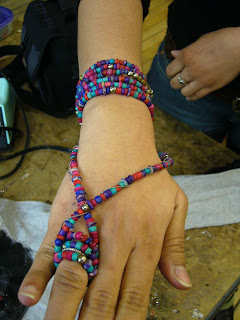itp.nyu.edu/~rjs425/Yaad.ppt

Above, is the representation of the malenge of technology and traditional artwork
The garment is a fascinating patchwork, with a glistening array of floral patterns a fascinating patchwork composition that is sewn by hand and embroidered with shiny sequins and beads. The cloth is first soaked in salt water for a day and then dried in the sun. The patterns are then traced out onto the cloth and spaced out keeping in mind the required space for the stitching. The embroidery is usually a collage of different patterns such that the based cloth is never visible. I selected to keep it simple and tried not to make it flashy as it is usually the case. I chose floral patterns with a row of peacocks. Usually most animal or animate figures come at the base of the garment while the lighter elements are arranged or dispersed all over the garment. The colors used are bright, joyous and seemingly random and an elegant fusion of magenta, red green and blue hues is maintained so that the garment is not just a piece of art but instead a blouse that can be worn occasionally. To differentiate from the traditional blouse, I have completely left out the use of mirrors and have sparingly used sequins. Mirrors are usually used to reflect off evil spirits. The light reflected would bring out the color of the thread used by reflecting light off them. To this traditional piece I wanted to add my touch of technology without really destroying its traditional appeal. In place of the mirrors, I used LEDs to do the same purpose.










